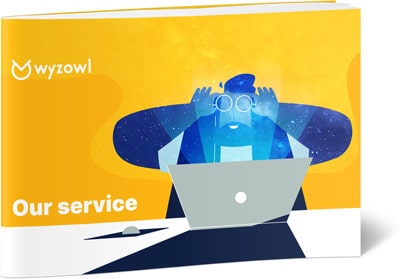Last updated on 10th January 2024
Let’s be real, employee training is a pretty big deal!
It’s not just about learning new skills to do the job but also about making sure employees are happy, engaged, and invested in their roles. A well-trained workforce is more productive, and who doesn’t want that?
But here’s the thing, “employee training” is a broad term that covers many different types of training methods. There are traditional training methods, like instructor led classroom training, hands-on training, and practical training. And then there are more modern, online training methods, like e-learning and computer-based training, which are super convenient and flexible.
We know it can be a bit overwhelming to choose the right employee training programs for your team, but don’t worry. We’ve got you covered!
In this article, we’ll explore the most effective training methods for employees, both old and new. We’ll discuss their strengths, weaknesses, and best use cases so that you can develop the right training program for your team.
By selecting the best training methods, you can help your employees develop new practical skills, boost their motivation, and engage them in their work.
Whether it’s a traditional training session or an interactive training method, we’ll help you find the best training methods to create a happy, productive workforce.
So, let’s dive in and discover the best types of employee training together!
Types of employee training methods
- On the job training
- Classroom instructor-led training
- Virtual instructor-led training
- E-learning or online training
- Simulations or virtual reality training
- Gamification or game-based training
- Job rotation
- Cross-training or multi-skilling
- Coaching or mentoring
- Peer-to-peer training
- Conferences or workshops
- Case studies or role-playing
- Self-directed or self-paced learning
- Microlearning or bite-sized training
- Mobile learning or m-learning
1. On the job training
On-the-job training is a type of employee training that takes place in the actual work environment. It’s like learning on the job, but with some extra guidance thrown in. This type of training can be a great way for employees to learn by doing and receive immediate feedback from their supervisors.
One of the coolest things about on-the-job training is that it’s super practical and relevant. Employees get to learn how to perform their job duties in real-life situations, which can help them develop a deeper understanding of the work they are doing. Plus, it can be customised to suit the needs of individual employees, making it all the more effective.

Another great thing about on-the-job training is that it can be cost-effective. There’s no need for additional training facilities or materials because employees are learning right where they work. That’s a win-win situation for everyone involved!
On-the-job training is also pretty flexible. It can be delivered in a variety of formats, from one-on-one coaching to group training sessions. This means that employees can learn at their own pace and integrate their new skills into their work gradually.
However, there are also some potential downsides to on-the-job training. One of the main weaknesses is that it can be unstructured and inconsistent. Without a clear plan or structure, employees may not receive a comprehensive understanding of the skills they need to develop. This can lead to knowledge gaps and inconsistent performance.
Another possible downside is that it can be time-consuming. Because the training takes place during working hours, it can take longer for employees to acquire new skills than with more structured forms of training, such as classroom or e-learning.
Finally, on-the-job training can be affected by the quality of the supervisory staff. If supervisors are not well-trained themselves or don’t have sufficient time or resources to devote to training, the quality of the training can suffer. This can lead to inconsistent results and a lack of employee engagement.
2. Classroom instructor-led training
Classroom or instructor-led training is like a lecture, but much more engaging.
This traditional form of employee training involves an instructor teaching a group of employees in a classroom setting.
Employees get to learn from skilled instructors who are experts in their field, and the curriculum is designed to cover all the necessary skills and knowledge in a comprehensive and cohesive manner. This can help ensure that employees are learning the right things and that they’re able to apply their new skills on the job.

Another advantage of classroom instructor-led training is that it’s interactive and engaging. This can help keep employees motivated and focused on their training. Plus, the group discussions and Q&A sessions can help foster a sense of community and collaboration among employees.
However, it’s important to keep in mind that classroom instructor-led training also has some potential drawbacks. For one thing, it can be time-consuming and may require employees to take time off work to attend the training sessions. What’s more, the costs associated with this type of training, such as instructor fees and classroom rentals, can add up quickly.
3. Virtual instructor-led training
Virtual instructor-led training, also known as VILT, is a type of employee training that takes place online. With the rise of remote work and digital technologies, VILT has become an increasingly popular way to train employees who may be working from home or in different locations.

One of the biggest advantages of VILT is that it’s flexible and accessible. Employees can attend the training sessions from anywhere with an internet connection, which can be especially helpful for businesses with remote or distributed teams. This type of training can also be more cost-effective than traditional classroom training, as there’s no need to rent a physical space or pay for travel expenses.
Another advantage of VILT is that it’s often highly interactive and engaging. Just like with classroom instructor-led training, employees get to learn from expert instructors and participate in group discussions and Q&A sessions. However, because VILT takes place online, there are also opportunities to incorporate digital tools and platforms to enhance the learning experience, such as virtual whiteboards or breakout rooms.
However, there are also some potential drawbacks to VILT. One potential weakness is that it may not be as effective for certain types of training, such as hands-on or physical skills training. Additionally, because VILT takes place online, there may be technical issues or distractions that can detract from the learning experience.
Overall, VILT can be a valuable form of employee training for businesses that want to provide their employees with flexible and accessible learning opportunities. By leveraging digital technologies and expert instructors, businesses can help their employees develop new skills and knowledge, even if they’re working from different locations.
4. E-learning or online training

E-learning or online training is like Netflix for employee training!
This type of training is delivered via the internet and can take many forms, such as corporate training videos, webinars, or interactive quizzes.
One of the biggest strengths of e-learning is that it’s highly flexible. Employees can complete the training modules on their own time and at their own pace, which can be especially helpful for busy or remote workers. Additionally, e-learning can be more cost-effective than traditional classroom training since there’s no need to rent a physical space or pay for travel expenses.
Another advantage of e-learning is that it’s often highly engaging and interactive. Modern e-learning platforms and tools make it possible to incorporate multimedia elements such as videos, animations, and interactive quizzes to enhance the learning experience. This can help keep employees motivated and focused on their training.
However, there are also some potential weaknesses of e-learning to keep in mind. For one thing, it may not be as effective for certain types of training, such as hands-on or physical skills training. Additionally, some employees may struggle with self-motivation or may have difficulty staying engaged when working through e-learning modules on their own.
Overall, e-learning can be a powerful tool for businesses looking to provide flexible and accessible training to their employees. By leveraging the latest e-learning technologies and techniques, businesses can help their employees develop new skills and knowledge, even if they’re working from different locations or on different schedules. However, it’s important to carefully consider the specific needs and goals of your business before investing in e-learning, as it may not be the right choice for every situation.
5. Simulations or virtual reality training
Simulator-style training or virtual reality (VR) training is like a video game that teaches you a new skill.
This type of training uses simulated environments to teach employees how to handle high-pressure or dangerous situations. Perhaps its most well-known use case is the way flight simulators are used to train pilots.

But simulators are also used for a variety of high-risk roles including surgeons and emergency responders.
The most obvious upside of this approach is that it allows people to make mistakes in a consequence-free environment.
It can also be highly engaging and customisable. With the help of simulations, employees can build critical thinking skills and develop problem-solving abilities by facing complex scenarios that require strategic decision-making.
Simulations can also be tailored to specific business needs and even to individual employees, making for a personalised learning experience that can be more effective than one-size-fits-all training programs.
Of course, there are some potential downsides to simulations.
For one thing, they can be expensive to develop and implement, especially if they require specialised software or hardware. And also, it may not be the best fit for all types of training – particularly those that require hands-on or physical skills.
6. Gamification or game-based training

Gamification is an innovative and engaging training method that has been gaining popularity in recent years. It is a type of employee training that incorporates game mechanics and elements to make learning more interactive and fun. The concept of gamification is based on the principle that people are naturally motivated by challenges, competition, and rewards, making it an effective way to motivate employees to learn and develop their skills.
One of the main strengths of gamification is that it encourages active learning. The use of game-like elements such as quests, badges, and points can motivate employees to engage with the content and take an active role in their learning. This type of training is especially effective in developing skills that require practice and repetition, such as sales techniques or customer service skills.
Another benefit of gamification is that it can be customized to the specific needs of each employee. This level of personalization can increase the effectiveness of the training, as employees can work at their own pace and focus on the areas that they need to improve. This flexibility also allows for a more efficient use of time and resources, as employees can complete the training at a time and place that is convenient for them.
Despite its many strengths, gamification also has its limitations. One potential downside is that it can be difficult to create a balance between game mechanics and learning objectives. If the game-like elements are too prominent, employees may become more focused on the competition rather than on the learning goals. In addition, gamification may not be the most effective training method for certain types of content, such as technical or complex information.
7. Job rotation
Job rotation is a great way to train employees by moving them around different roles in the company.
This helps them develop new skills, understand the business better, and prepares them for future leadership roles. Employers benefit too because they get a flexible workforce that can adapt to changing business needs.
Job rotation has loads of benefits. It improves employee engagement and satisfaction because people feel valued and invested in the company. It also helps identify future leaders and can make organisations more agile.
But job rotation can have some drawbacks. Employees may feel anxious or stressed when they move to a new role. And it can disrupt teams if key people get moved around too much.
Overall, job rotation is an effective way to train employees and provides benefits for both employees and employers. It can help businesses stay ahead of the competition, and while there are some drawbacks, they can be minimized with careful planning and communication
8. Cross-training or multi-skilling
Cross-training or multi-skilling is like learning how to play multiple instruments in a band.
It’s about teaching employees to perform tasks that are outside their primary job responsibilities.

This training can be done in a bunch of ways, like classroom training, on-the-job training, and mentoring. It’s up to the company to decide which method works best for them.
To start, the company needs to figure out what skills and jobs are most important. Then they make a plan that teaches employees how to do those things. Employees might have to follow experienced staff around or practice new skills while being watched.
Once the training is complete, employees can start using those new skills. This might happen slowly so that everyone can adjust to the changes.
Equally, it might be a long time before anything changes. Many businesses use cross-training simply to deepen understanding of how the business works, or as a contingency in case of absence or illness.
Cross-training is a great way to make the company more flexible and able to change quickly when needed. It also helps employees feel more engaged and satisfied with their work because they get to learn new things, get a greater understanding of where they work, and have a greater sense of purpose.
9. Coaching or mentoring
Coaching and mentoring are both powerful training techniques that can be used to help employees develop new skills and reach their full potential. While they are often used interchangeably, coaching and mentoring are actually two different approaches to training.
Coaching typically involves working one-on-one with an employee to identify areas for improvement and create a plan for achieving their goals. This might involve providing feedback, setting goals, and providing support and guidance as the employee works to improve their skills.

Mentoring, on the other hand, is more focused on building relationships and providing guidance and advice over a longer period of time. Mentors are typically more experienced and knowledgeable than their mentees, and they use their expertise to help guide the mentee’s career development.
Both coaching and mentoring have a range of benefits for employees and employers. They can help employees to develop new skills and knowledge, improve their performance, and increase their engagement and job satisfaction. They can also help to identify future leaders within the organisation and build a more collaborative and supportive workplace culture.
To implement coaching and mentoring programs, organisations can assign coaches or mentors to employees based on their skills, experience, and career goals. Training can be provided to coaches and mentors to ensure they have the necessary skills and knowledge to provide effective support and guidance.
10. Peer-to-peer training
Peer-to-peer training, also known as peer learning, is a training technique that involves employees teaching and learning from each other. In this approach, employees share their knowledge and expertise with their peers, helping them to develop new skills and knowledge.

Peer-to-peer training can take many forms, including informal discussions, group projects, mentoring, coaching, and on-the-job training. It can be especially effective for teaching soft skills such as communication, collaboration, and leadership, which are often best learned through experience.
One of the benefits of peer-to-peer training is that it can be more flexible and responsive to the needs of the organisation than traditional training methods. Instead of relying on outside trainers or formal training programs, employees can learn from each other in a way that is tailored to their specific needs and interests.
Peer-to-peer training also promotes a culture of collaboration and knowledge sharing within the organisation. It encourages employees to take ownership of their own learning and development, and to view themselves as active contributors to the success of the organisation.
To implement peer-to-peer training programs, organisations can create opportunities for employees to collaborate and learn from each other. This might involve creating peer coaching or mentoring programs, encouraging employees to share their knowledge through internal blogs or forums, or incorporating group projects and team-based learning activities into training programs.
11. Conferences or workshops

Conferences and workshops are a great way to offer training opportunities to employees. They are usually held in-person or virtually, and provide a chance for employees to network, learn from experts, and explore new ideas.
One of the biggest advantages of conferences and workshops is that they offer a unique learning experience that can be hard to replicate in-house. Attending a conference or workshop can expose employees to new concepts and perspectives that they might not have encountered otherwise. Additionally, these events often offer opportunities for hands-on learning, which can help employees better understand and retain the material.
Another benefit of conferences and workshops is that they can be tailored to specific industries, topics, or roles. This means that employees can attend events that are directly relevant to their work, and gain new skills or insights that will benefit their job performance.
Of course, there are some downsides to consider as well. Conferences and workshops can be expensive, both in terms of registration fees and travel costs. Additionally, not all events are created equal, so it’s important to do your research and choose ones that offer high-quality training.
12. Case studies or role-playing
Case studies and role playing are two training techniques that can be fun and effective ways to help employees develop new skills and knowledge.
Case studies involve presenting employees with a real-world scenario or problem and asking them to analyze and solve it. This technique can help employees develop critical thinking and problem-solving skills, and can also help them to see how the skills they are learning can be applied in a practical setting.

Role playing involves asking employees to act out a scenario or play the role of a specific person in a simulated situation. This technique can be especially effective for teaching communication and conflict resolution skills, as employees can practice interacting with each other in a safe and controlled environment.
Both case studies and role playing can be engaging and interactive training techniques that allow employees to learn by doing. They can also be adapted to a range of different learning styles and can be used to teach a variety of skills, from leadership and teamwork to customer service and sales.
To implement case studies and role playing in training programs, organisations can create scenarios and situations that are relevant to their industry or specific job roles. They can also provide training and support to trainers to ensure they have the necessary skills to facilitate these activities effectively.
13. Self-directed or self-paced learning
Self-directed or self-paced learning is a training technique that allows employees to take control of their own learning and development. Instead of being led by a trainer or instructor, employees are given the freedom to choose what they want to learn, how they want to learn it, and when they want to learn it.

This approach can be especially effective for employees who prefer to learn at their own pace or who have busy schedules that make it difficult to attend formal training programs. It can also be a great way to help employees develop the skills they need to advance in their careers, without requiring them to take time away from their work.
Self-directed learning can take many forms, including online courses, webinars, podcasts, and books. It can also involve job shadowing, mentorship, and on-the-job learning experiences.
To implement self-directed learning in training programs, organisations can provide employees with access to a range of learning resources and support, such as online courses, coaching, and mentoring. They can also create opportunities for employees to share their knowledge and expertise with each other through internal blogs or forums.
14. Microlearning or bite-sized training

Microlearning is a training technique that involves breaking down learning content into small, bite-sized chunks that can be easily consumed and retained by learners. These short learning modules typically last no longer than 5-10 minutes and can take many different forms, including videos, quizzes, podcasts, and infographics.
Microlearning is becoming an increasingly popular training technique, as it offers many benefits over traditional training methods. For one, it is much more flexible and can be accessed from anywhere, at any time. This makes it perfect for employees who have busy schedules or who are always on the go.
Another benefit of microlearning is that it is more engaging and interactive than traditional training methods. By breaking learning content into smaller pieces, learners are more likely to stay focused and retain information. Microlearning can also be personalized to the needs and interests of individual learners, which can help to improve engagement and motivation.
To implement microlearning in training programs, organisations can create short learning modules that cover specific topics or skills. They can also provide learners with access to a range of different learning resources, such as online courses, podcasts, and quizzes.
15. Mobile learning or m-learning
mLearning, or mobile learning, is a training technique that involves using mobile devices such as smartphones and tablets to deliver learning content. This technique is becoming increasingly popular, as it allows learners to access training content from anywhere, at any time.

The benefits of mLearning are many. For one, it is highly flexible and can be accessed by learners regardless of their location. This means that learners can continue to learn and develop their skills even when they are not in the office. Additionally, mLearning is highly interactive, with content often delivered through interactive quizzes, videos, and games.
Another benefit of mLearning is that it can be tailored to the individual needs and interests of learners. This means that learners can choose the topics they want to learn about and access content that is relevant to their specific job roles and responsibilities.
To implement mLearning in training programs, organisations can create mobile-friendly learning modules that can be accessed from any mobile device. They can also provide learners with access to a range of different learning resources, such as podcasts, webinars, and videos.
Which employee training method is best?
With so many different employee training methods at your disposal, which are the ones that work for you? The answer, frankly, is that you don’t know until you try!
Trying things out and having an honest, open-minded approach – a willingness to strip back what doesn’t work, and double down on what does – is the best way to build a training strategy that works.
So trust your instincts, keep an open mind – and get stuck in!
For more information on how to get started with employee training, check out our new hire videos page.





